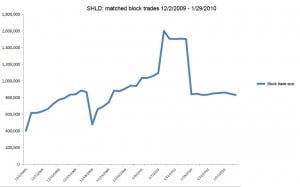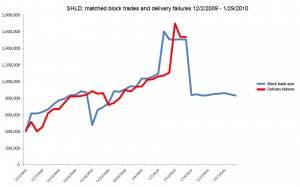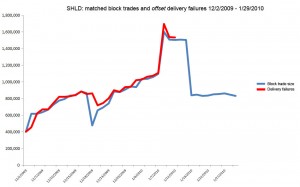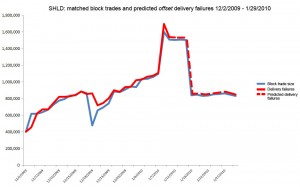Most of the examinations of stock manipulation published here on
deepcapture.com take place after the fact, the damage being done.
However, we’ve became aware of instances of apparently
illegal, manipulative trading in several companies’ stocks,
happening right now, which we have the ability to monitor
and report on in nearly real time.
I’ll starting with Sears Holdings Corporation
(NASDAQ:SHLD).
A few months ago, an unusual trading pattern in shares of Sears
emerged, in which large blocks of shares change hands within
minutes of deep in-the-money call options equivalent to precisely
the same numbers of shares in these blocks. This behavior is
consistent with the illegal “reset” transaction
described
in the enforcement case brought by the SEC against naked short
seller Steven M. Hazan:
“…a market participant who has a
“fail-to-deliver” position in a threshold security buys
shares of that security while simultaneously selling short-term,
deep in-the-money call options to – or buying short-term,
deep in-the-money put options from – the counterparty to the
share purchase. The purchase of shares creates the illusion that
the market participant has satisfied the close out obligation of
Reg SHO. However, the shares that are apparently purchased in the
reset transactions are never actually delivered to the purchaser
because on the day after executing the reset, the option is either
exercised (if a call) or assigned (if a put), transferring the
shares back to the party that apparently sold them the previous
day. This paired transaction allows the market participant with the
fail-to-deliver position to effectively borrow the stock for a day,
in order to appear to have satisfied the close out requirement of
Rule 203(b)(3).”
If you want to see the each of these reset transactions in
detail, you can do so here. But if you’re content with
the bottom lines, take a look at this
table, keeping in mind each call option contract gives the
buyer the right to purchase 100 shares of the underlying stock
(meaning, these trades were undeniably “matched” to one
another).
Take a look at how these blocks trades appear when charted.

SHLD matched block trades: click to enlarge
Looking at the relationship between these matched blocks and the
delivery failure data currently available suggests the blocks are a
pretty reliable predictor of delivery failures reported two days
later.

SHLD matched block trades and delivery failures: click to
enlarge
Moving fails back two trading days we see just how reliable a
predictor these matched block trades really are.

SHLD matched blocks and failed trades, offest -2 days: click to
enlarge.
On average, SHLD fails are roughly 102% of these matched blocks.
Given that relationship, I feel quite confident predicting how the
as-yet-unreleased SHLD delivery failures will appear (note the
dashed line).

SHLD matched block trades and offset delivery failures with
prediction: click to enlarge
Now for the good and bad news inherent to this situation.
The good news is: this unusual market activity is fairly easy to
spot.
The bad news is: despite being easy to spot, in recent months
multiple companies have come under identical attack, suggesting
whoever is responsible is not too concerned about the
consequences of overtly violating the securities laws…a
familiar situation for anybody who’s followed deepcapture.com
for any length of time.
I’ll have more on this subject as soon as the SEC fails
data are released, so stay tuned.
UPDATE:
Last week I dared to
predict the number of then unreleased delivery failures in
shares of Sears Holdings (NASDAQ:SHLD). The figures I ultimately
settled upon (after two minor tweaks in the days to follow)
were:
1/29/2010 879,444
1/28/2010 873,222
1/27/2010 870,570
1/26/2010 851,904
1/25/2010 848,742
1/22/2010 865,266
1/21/2010 857,106
1/20/2010 1,535,508
1/19/2010 1,540,914
This morning, the SEC having yet to release the numbers, I
explained
the basis for my prediction, which is in simple terms, based on
a pattern of apparently manipulative naked short
“reset” transactions the Deep Capture team has observed
in SHLD, and how those trades consistently predict how many shares
of SHLD will fail to deliver after two days.
Well, literally moments after I published my explanation,
the SEC released the numbers.
I asserted that my prediction would be accurate to within
+/-2.5%. I’m embarrassed to reveal that in the end, my
predictions were on average accurate to within 2.55%.
Sorry. I’ll try harder next time  .
.
At this point, the most relevant question is: will the SEC
do anything about this obvious violation of the law?
Sadly, I predict that no, the SEC will not.
The next most relevant question is: will the manipulator
continue manipulating, knowing he or she has been spotted?
Because I suspect the manipulator is operating without much
concern over being held accountable, I must also predict that no,
this pattern is unlikely to change.
However I can confidently predict that Deep Capture will
continue identifying and reporting on these sorts of abuses, in the
trading of SHLD and several other companies, in the very near
future.
Mostly inconsequential
postscript: Deep Capture team member Patrick Byrne, who
possesses a doctorate degree in mathematical logic, points out to
me that instead of average error, I should have used weighted
error, in which case my prediction was off by just
2.51%.
Judd Bagley is a reporter
for Deep Capture

